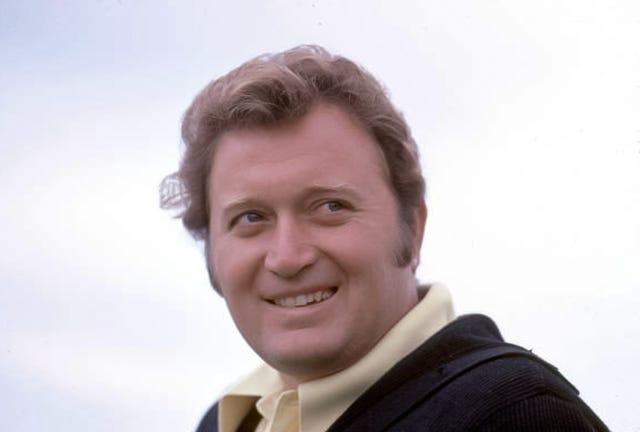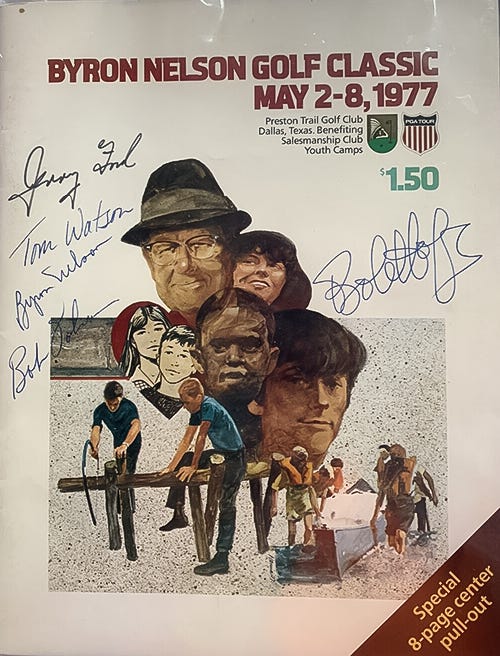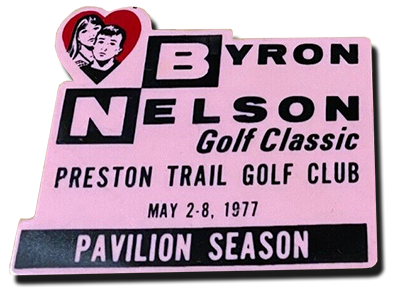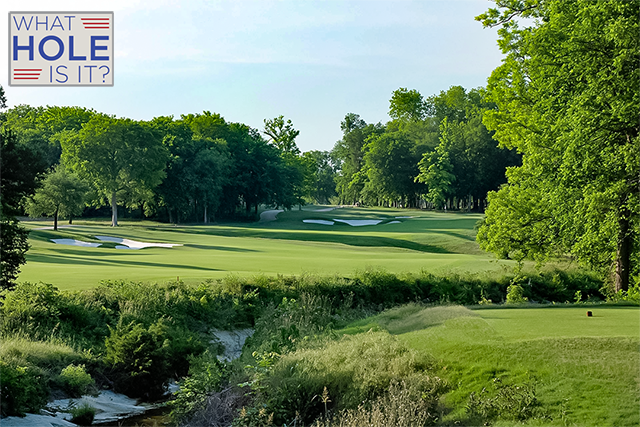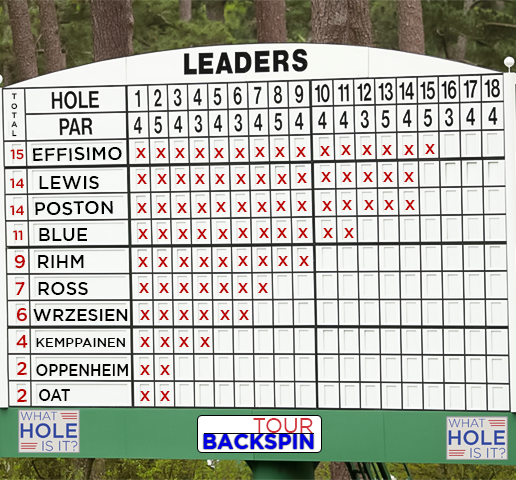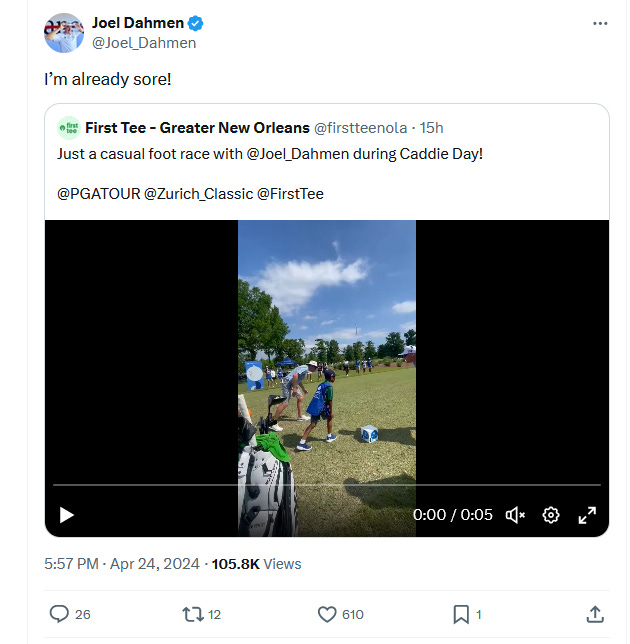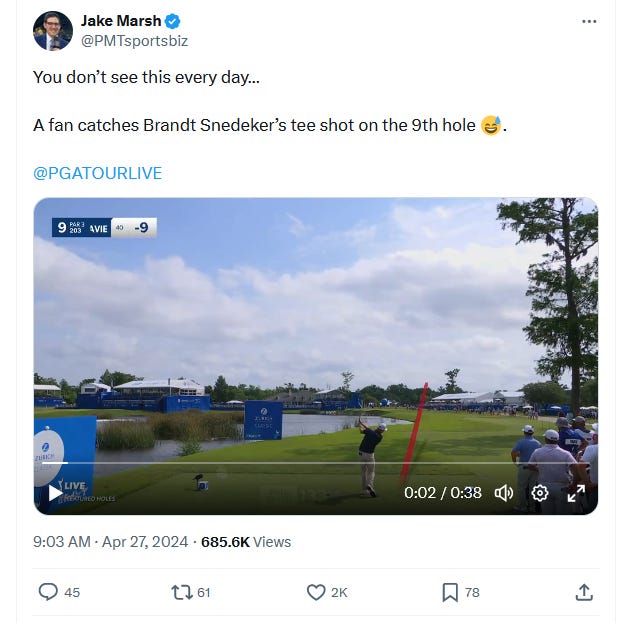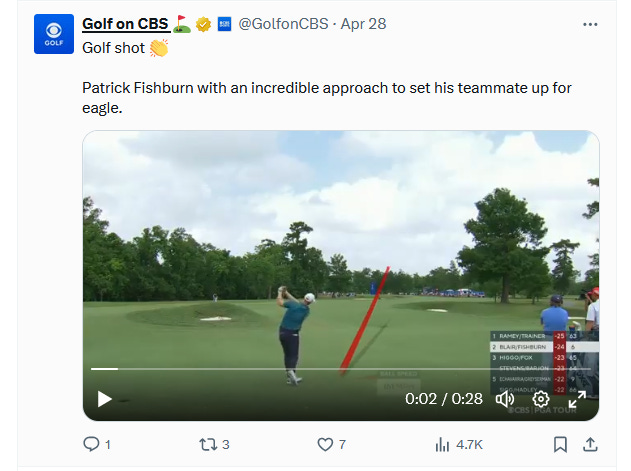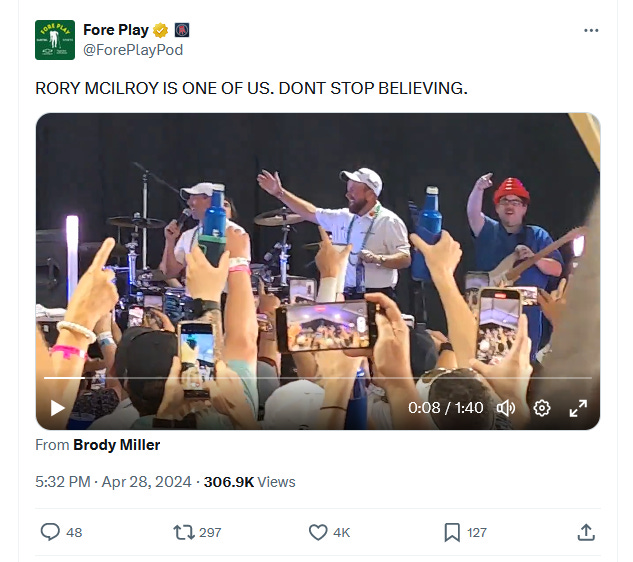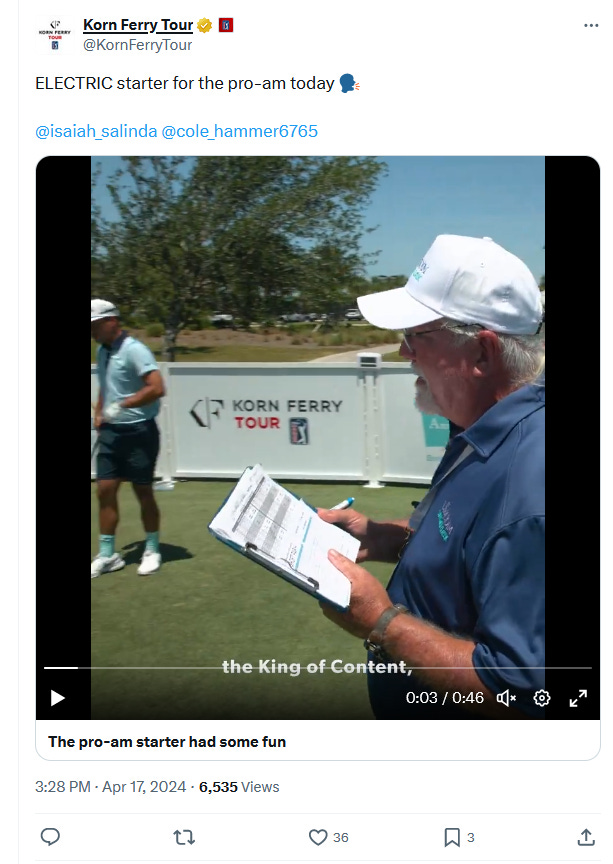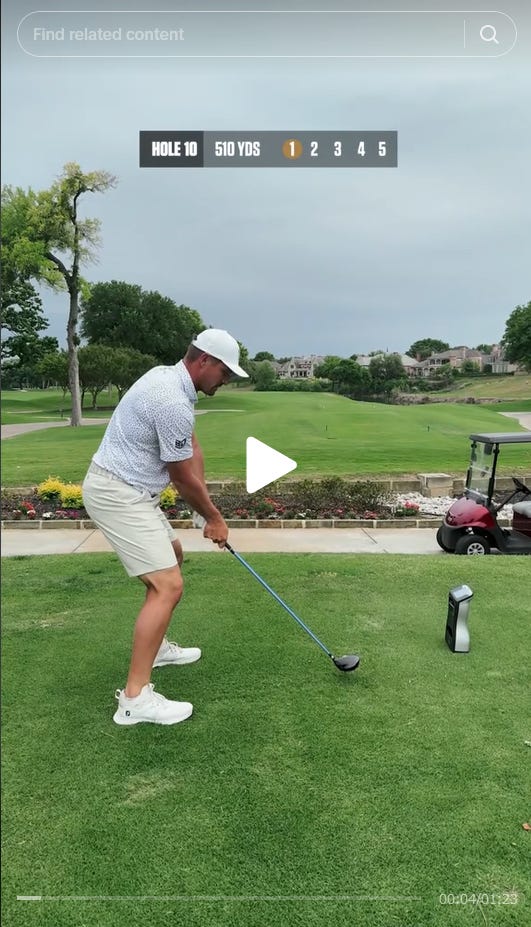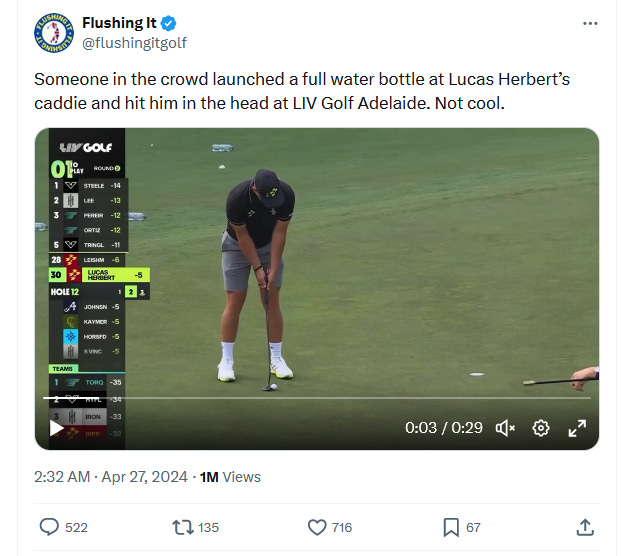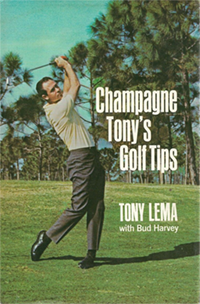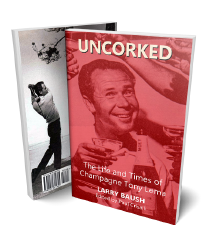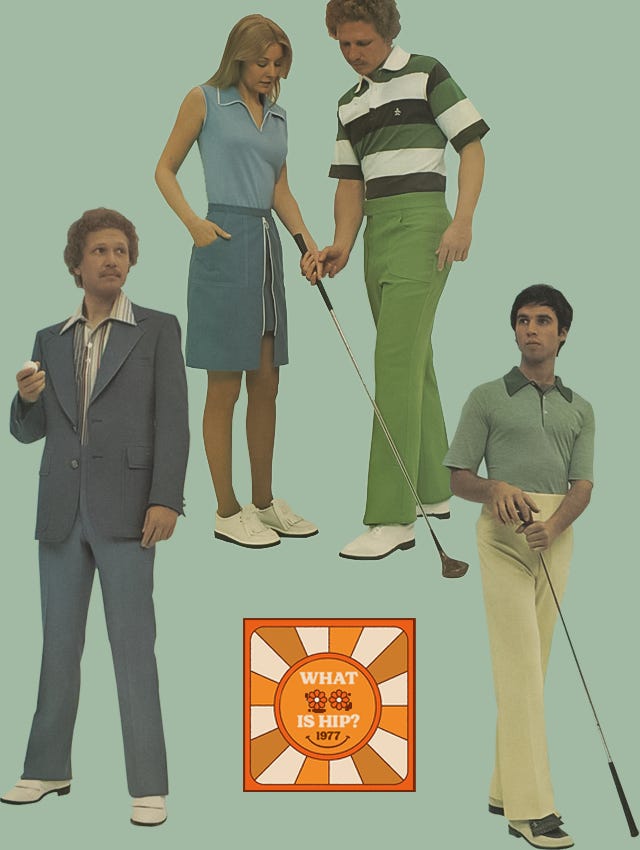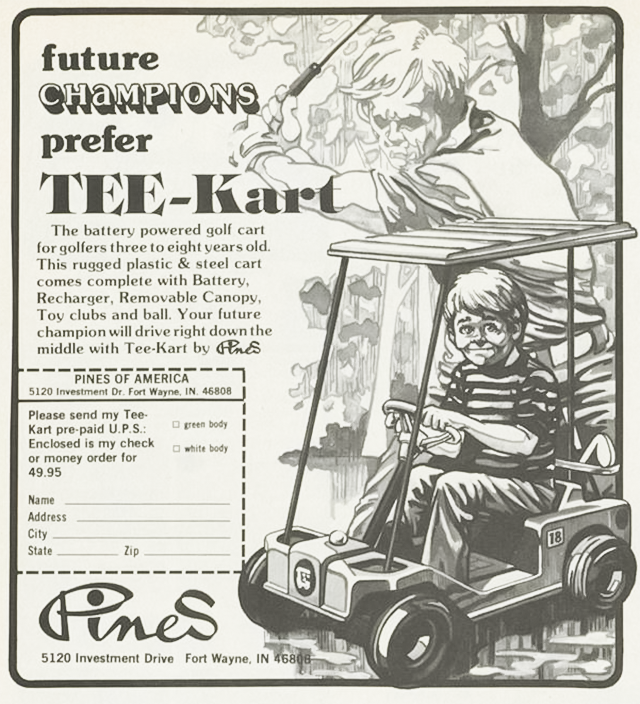Back in February, we spoke with Ben Crenshaw about his 1981 Mexico Open victory where he had to beat Raymond Floyd. Crenshaw said is was a satisfying win because Floyd usually got the better of him when they were head-to-head whenever they were in contention and the tournament result was still undecided. This week, our journey through the past revisits the 1977 Byron Nelson Golf Classic which was an example of what Gentle Ben was speaking of. Scroll down to learn how this tournament came down to the last few holes.
Even though it was not a major, or a Signature Event, the Zurich Classic of New Orleans did provide some interesting viewing for golf fans. The final holes showed that there are many different kinds of pressure that a PGA TOUR pro faces. Scroll down for the Clips You Might Have Missed, a few thoughts on the week from me, a recap of the tournament and highlights.
The CJ Cup Byron Nelson is up next on the tour schedule. This tournament dates back to 1944 when Byron Nelson won the Texas Victory Open by ten strokes over Jug McSpaden. We wrote about the 1969 Byron Nelson Golf Classic won by Bruce Devlin, a close friend of Tour Backspin, and the 1960 Dallas Open where Johnny Pott captured his first PGA TOUR title.
I worked as a spotter at my home club, Rainier Golf and Country Club, for the sectional qualifying for the Women’s U.S. Open, also known as the longest day in golf. The final qualifiers were not decided until 8:30 pm when a three-for-two playoff was finally decided. Jiwon Jeon was the medalist, and Emily Kristine Pedersen and Caroline Inglis survived the playoff with Ssu Chia Cheng being eliminated on the seventh playoff hole. Read more HERE. We wrote about when Rainier hosted the 1959 Women’s Western Open, recognized by the LPGA as a major.
We want to hear from you in the Tour Backspin Poll, and this week’s Music Clip features Stevie Wonder doing a live version of Sir Duke in 1977. We look at the long and powerful swing of Byron Nelson in this week’s Swing Like a Pro and bring you another tip from Tony Lema. You’ll know this week’s WHAT HOLE IS IT? so let us know your answer and you may just win a golf swag prize pack. Of course, we’ve got some links for you in the Check it Out section and I’m blown away by this week’s Vintage Ad. How could it sell for so cheap, and what parent, in their right mind, would buy this “toy” for their kid (age three to eight years old)? Scroll down to view.
We understand if you can’t pay for a premium subscription and we’re happy to have you here however you’ve arrived. You can sign up for a free subscription so you’ll never miss the newsletter. It will arrive in your inbox every Thursday.
In last week’s Tour Backspin Poll we wanted to know what you thought were the contributing factors to the lower TV ratings for the PGA TOUR this year. There were 66% of respondents who felt is was due to the many streaming options that are now available, and 33% who felt lower ratings were due to too many commercials and poor production values.
This week we want to know how you feel about team events on the PGA TOUR Let us know in this week’s Tour Backspin Poll.
Tour Backspin Poll
Do you know what happened today in golf history? Or which famous golfer has a birthday today? Me, neither. But I do know where to go to find out. Check out the Your Golfer’s Almanac podcast. Host Michael Duranko celebrates birthdays, milestones, and other accomplishments that occurred on this day in golf history. Listen HERE.
We’re playing Byron Nelson Trivia in this week’s Tour Backspin Quiz. Scroll down to play.
Did you miss a previous newsletter? You can view it HERE. Help us grow Tour Backspin! Please forward this email to a friend. Was this newsletter forwarded to you? You can sign up HERE.
Okay, we're on the tee, let's get going.
Enjoy!
Larry Baush
Floyd and Crenshaw Battle at the Byron Nelson
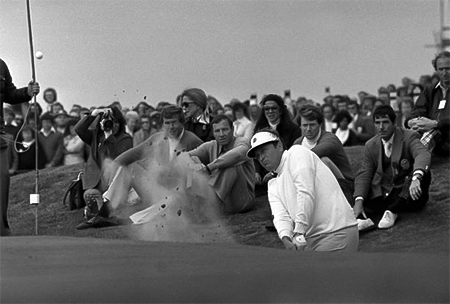
It is early in the morning of Wednesday, May 4th, 1977, and Johnny Miller is in the locker room of the Preston Trail Golf Club in Dallas, TX, when he is startled by the sight of a police K9 officer. The officer is handling his dog partner who is sniffing around the lockers and the bathroom. Miller suddenly recalled that former President Gerald R. Ford was scheduled to play in the day’s pro-am that proceeded the start of the Byron Nelson Golf Classic and realized that there would be a higher level of security than what one would normally see at a PGA TOUR event.
After visiting the Lyndon B. Johnson library in Austin, TX, on Tuesday, Ford traveled to Dallas where he would be teeing it up alongside Masters winner Tom Watson, comedian Bob Hope, host and former tour player Byron Nelson, and Ed Sammons, the tournament director in the pro-am.
Ford arrived at Preston Trail, a 6,983-yard, par 71 course, in a helicopter, that landed on the front lawn. He was fully equipped for the day with his flashy black and gold golf bag filled with custom-made engraved clubs and a gold putter. After a little warmup, he made his way to the first tee where fans lined the tee and fairway. He promptly hit his first tee shot out of bounds.
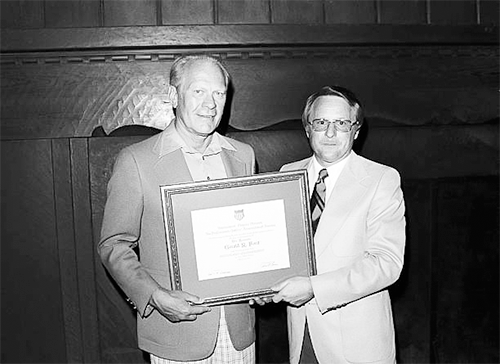
Despite receiving numerous lessons from Nelson, the former president’s play got worse. He hit several shots out of bounds, skulled a bunker shot that scattered spectators, and in a hilarious high (or low?) point, hit a tee shot that only traveled 20-yards and hit his own golf bag.
A helicopter patrolled the sky as the fivesome played, and the Secret Service deployed a dozen agents who followed the group on scooters including one that carried medical equipment for any emergency that might come up.
With all the distractions, it was no wonder that the team could do no better than five-under and Watson shot a mediocre 73. Watson, who was considered a favorite to win that week, said he was not unhappy with the score.
“Well, it was pretty hard to concentrate. I got pretty involved in our group.” He said.
Ben Crenshaw and Billy Casper tied with a score of three-under-par 68 for the low round on the windy day. Crenshaw hoped that it was a harbinger of good things as he had been off his game for most of the season. He would be teeing off at 8:56 on the tenth tee in the next day’s first round.
A special press conference was called early on Thursday where Bruce Crampton announced his retirement. He explained that he wanted to spend more time with his family.
“I want to start living a little bit and be a family man, so to speak,” Crampton explained. “I found it difficult traveling with two children last summer. It was difficult on Joan (his wife). We need to be a family.”
“I just started making everything in sight.”
A steady south wind blew over Preston Trails in the first round and Lyn Lott, a player who came out on tour in 1974 with his best finish a third-place finish at the 1976 Canadian Open, took the lead with a 68.
He started his round on the 10th hole and got off to a slow start scrambling for pars on his first two holes before bogeys at the 12th and 14th holes. At the 17th hole he hit a 7-iron to within 10-feet of the hole and made the putt. His putter then got hot, and he made birdies at the next two holes.
“I just started making everything in sight,” he said after his round.
Lott was unfazed by the wind saying, “It was consistent. I knew what it was going to do all the time. It wasn’t gusting.”
“There are pretty severe conditions about three or four yards out in the rough. It’s tougher than last year because it seems then you could hit it in the trees and still get on the green.”
Ray Floyd was one stroke off Lott’s lead at 69 and was tied with Fuzzy Zoeller and Ben Crenshaw. Floyd spoke about the conditions after his round.
“Anyone who isn’t hitting the ball straight won’t be scoring well,” he explained to reporters after his round. “There are pretty severe conditions about three or four yards out in the rough. It’s tougher than last year because it seems then you could hit it in the trees and still get on the green.”
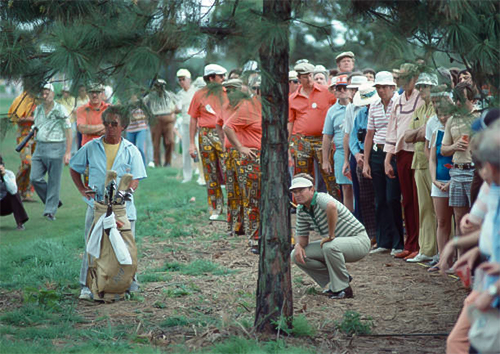
For his part, Crenshaw was happy with his round and said, “This was a good round for me. I thought the ball went around the course pretty well today.”
The wind finally died on Friday although the sky was cloudy. The conditions were ripe for scoring, but nobody was able to go very low.
“There was no comparison to playing conditions to those of yesterday. I’m really surprised that no one has pulled away,” Lott said after shooting an even-par 71 for a 171 total.
“I think I became mentally drained having to wait so long.”
Crenshaw, Floyd, and Zoeller all shot 70 and were tied with Lott. Zoeller had it to five-under for the tournament before scoring two bogeys on the back nine. He put part of the blame on the pace of play.
“I think I became mentally drained having to wait so long,” he said after his round.
Floyd felt that he was “very fortunate” in the tee-time draw that resulted in him missing the worst of the winds during both his rounds.
Crenshaw was not happy about his round saying it was “Absolutely awful. Only my short game is keeping me alive. I’m very fortunate to be in this position.”
His up-and-down round included a double-bogey on the par-4, 7th hole and an eagle three on the 15th hole where he chipped in from six-feet off the green.
“I’m extremely disappointed in my game,” Crenshaw continued. “I just can’t seem to find it . . . and it’s disturbing the hell out of me.”
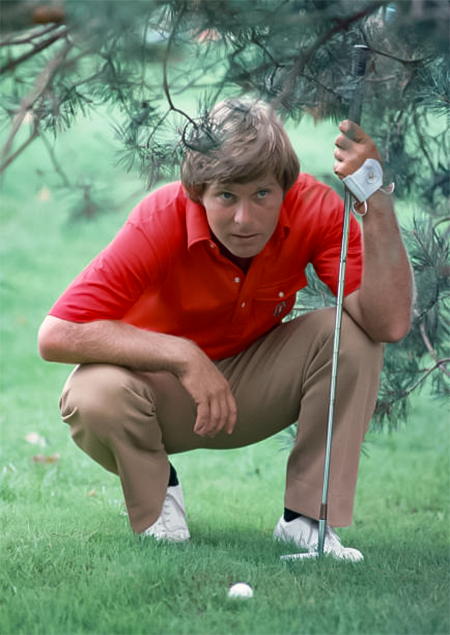
Charles Clines of the Fort Worth Star-Telegram compared the third round to that day’s running of the Kentucky Derby, won by Seattle Slew in a close finish. Clines wrote:
Saturday may have been a good day to run the Kentucky Derby, but THE horse race shaping up is at Preston Trail where Ben Crenshaw and Ray Floyd are nose-to-nose heading down the final stretch in the Byron Nelson Golf Classic.
"If we do play each other, another guy may make three or four birdies, and all of a sudden, we’re behind.”
Both Crenshaw and Floyd carded 68s, for a total of 207, and enjoyed a three-stroke lead over Lott who had a 71. Zoeller fell out of contention after soaring to a 73. The weather conditions were improving with warm temperatures and light breezes. Floyd, for one, was concerned that someone could get hot in Sunday’s final round. He was also concerned that he and Crenshaw would focus too much on each other and a player like Bill Krazert or Ed Sneed, four-strokes off the lead, could catch them.
“We’ll have to be careful,” he said. "If we do play each other, another guy may make three or four birdies, and all of a sudden, we’re behind.”
Crenshaw saw some improvement in his play from the day before, yet he was surprised that he and Floyd were able to pull away from the pack.
“If someone had told me before I teed off that I could shoot a 68 and not only be in the lead, but three shots out of third, I wouldn’t have believed it,” he said.
One thing that was vexing to him, though, was that he bogeyed the 5th hole for the second consecutive day.
There were 29 scores under par on Saturday compared to only 12 on Friday. Both Floyd and Crenshaw birdied the final hole. Crenshaw would be in the last group the next day with Floyd in the group behind him.
Just as Floyd feared, both he and Crenshaw came out flat and suddenly had Lyn Lott and Jerry McGee nipping at their heels. The crowd favorite, Crenshaw, found his game and looked poised to run away with the tournament when he birdied the par-5, 10th hole while Floyd continued to flounder.
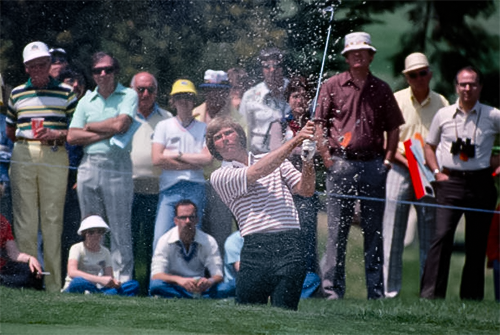
A bogey by Crenshaw at the 14th halted his momentum briefly but he boomed a long drive on the par-5, 15th hole and followed up with a laser of a 1-iron to within 20-feet of the hole. The crowd went crazy as he stroked the putt into the hole for an eagle giving him a three-stroke lead over Floyd. He wasn’t counting his money yet, though.
“Not the way I’ve been playing this week,” he admitted after his round. “I still had a lot of golf left and it wasn’t an easy lock.”
While Crenshaw examined a tight lie at the 17th, he heard a roar go up from the 15th hole and knew that Floyd had matched his own eagle at the 15th hole.
“I could have quit, but I came back with a hell of an eagle and I was right back in contention.”
“That made it more difficult,” he said about the shot he faced. He made a bad club decision, and his 8-iron flew the green into the tall grass. He chipped to 15-feet and missed the par putt.
Crenshaw was not the only one who heard roars from other holes as Floyd was aware of Crenshaw’s eagle at the 15th when he heard the reaction from the crowd.
“I knew I was now three behind. I subconsciously kicked myself in the behind,” Floyd said after his round. “I could have quit, but I came back with a hell of an eagle and I was right back in contention.”
His 30-foot eagle putt at the 15th really got Floyd going.
“I hit a perfect putt, and it was the prettiest thing I’ve ever seen,” Floyd said.
But it may have been his shot at the par-3 16th that would turn out to be the shot of the day. He hit his tee shot fat and it barely cleared the water fronting the green before bounding up onto the green, ten feet from the hole. He failed to make the putt, but gained a stroke on Crenshaw who was bogeying the 17th hole at the same time.
Floyd split the fairway with his drive on 17 and then hit an 8-iron approach to seven feet. As he walked toward the green, he noticed that Crenshaw was having tree trouble at the final hole and when he stroked in his birdie putt, he felt he could win the tournament.
Crenshaw pushed his drive at the final hole into the trees resulting in a near impossible lie. He was unable to recover and finished with a bogey. Floyd made a steady par at the final hole for a two-stroke victory.
“I’m drained,” Floyd admitted after the round. “This has been a long, tough week. I can’t remember a tournament where I’ve been either two in front or two behind the entire four rounds. That’s tough and I feel like I could drop.”
Floyd accepted the $40,000 first-place check while Crenshaw collected the $22,800 second-place money. Andy Bean had rounds of 65 and 67 on the weekend to finish in a tie for third place with Lott and both collected $11,800.
On a week that stared with the flashy arrival of a former president, it was a fantastic finish on Sunday that provided the excitement for the spectators at Preston Trails and the audience watching the national broadcast on ABC.
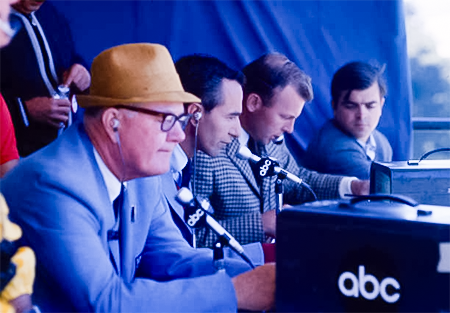
Follow us on Facebook, Instagram, Twitter, YouTube and Threads.
BONUS STORY
The Par-3 11th hole at Preston Trail provided a perfect example of golf’s Yin and Yang in Friday’s second round of the Byron Nelson Golf Classic in 1977.
Bobby Strobe was 2-over for the tournament when he came to the hole with water guarding the front of the green. He proceeded to hit two balls into the water. When he finally reached the green, he three-putted for a 9. He missed the cut.
Alan Tapie came along a little while later and hit his 5-iron into the cup for an ace helping him tie Dan Sikes for the low round of the day.
Golf giveth, and golf taketh away.
The Tour Backspin Show with our guests Jim McLean and Craig Welty has been unlocked for all subscribers. Want to get podcasts two weeks early? Upgrade to a premium subscription today to listen early. We talk about Craig’s dad, Carl Welty, and about how he used video to study the golf swing. Listen HERE.
Listen to The Tour Backspin Show podcast on Substack with the above links, or on Spotify, Apple Podcasts, or iHeart Radio.
WHAT HOLE IS IT?
Are you on the leader board?
Congratulations to David Rihm who correctly identified #16 at TPC Louisiana, in Avondale, LA, in last week’s WHAT HOLE IS IT? contest. David beat out three other correct answers in the random drawing and a prize pack is on its way to him. Submit your answer for this week and get yourself into the race for the Herbert C. Leeds Trophy, our new perpetual trophy for the annual winner.
PGA TOUR Wrap-Up | Zurich Classic of New Orleans
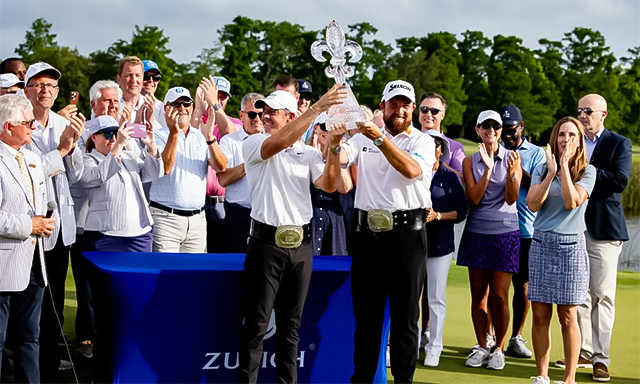
How much fun is it to watch alternate shot being played by PGA TOUR pros? We all know the draining feeling when you let down your partner playing alternate shot and you could see it on the faces and body language of the players who were in the hunt coming down the final holes on Sunday.
Yes, these guys play alternate shot in the Ryder Cup, but that is a team event and there are other players to pick you up when you come up short. With two-man teams, a bad shot just had to be dealt with by your playing partner and it was fun to watch the team dynamics when things went off the rails.
It’s no wonder that the team of Rory McIlroy and Shane Lowry, two Ryder Cup veterans, were able to handle the pressure late in the final round better than the other teams. The team of Chad Ramey and Martin Trainer finished their round, shooting a tournament-record tying 9-under 63, to get into the playoff with McIlroy and Lowry. Ramey and Trainer finished their round 2 hours and 59 minutes before the playoff began.
They finished their round so early that there was little time to feel the pressure, but it was apparent that they felt it in the playoff. Facing a fairway wood shot into the 18th hole with the wind blowing from right to left, Ramey aimed his second shot over the water guarding the right side of the green. A very tough shot to hit under normal circumstances, but in a playoff, with a partner to play for, the pressure must have been intense. He hooked his shot up against the built-out grandstands, and then Trainer showed that he was not immune to the pressure by chunking his difficult pitch shot.
Lowry showed some nervousness coming down the stretch missing some crucial putts but McIlroy was able to lend a steady hand, especially with a chip to the final green that got the pair into the playoff. Lowry hit his second shot at the first playoff hole into a bunker short of the green and left a difficult long bunker shot for McIlroy. McIlroy blasted out fairly close but Lowry missed the birdie putt. The resulting par was good enough to win the playoff.
Read the tournament recap by Adam Schupak of the Golfweek USA Today HERE.
See the top five shots from New Orleans HERE.
Clips You Might Have Missed
Pre-tournament fun.
Dude looks like he’s ready to turn a double play.
This team played well . . . until they didn’t.
Cameraman goes above and beyond.
This is incredible from Rory. Doesn’t seemed like he used a screen, or notes.
Give this guy a promotion to the PGA TOUR.
Bryson doing Bryson things.
Danger!
Tour Backspin Quiz | Byron Nelson Trivia
What technological change in golf equipment led Byron Nelson to develop a golf swing with more leg drive leading to him being thought of as the father of the modern golf swing?
Scroll down for answer
Swing Like a Pro
Byron Nelson in 1945.
Tip From Tony Lema*
Audio excerpts from the book Champagne Tony’s Golf Tips by Tony Lema with Bud Harvey.
(Click on player and scroll down when page opens)
The most common practice error is to drift aimlessly out to the practice tee and start banging balls at random. This isn't practice. This is just a waste of time and you'd be better off out on the course. At least, out there you'd be firing at live targets. The worst thing you can do is go out and practice your errors. You should never approach the practice range without a purpose, without a problem to be solved. And, it should follow from this that, when that particular problem has been solved, or at least reduced to tolerable proportions, the practice session is over. Never hang around the practice tee looking for new trouble.
*AI generated voice
Blind Shot
Click for something fun. 👀
What was the best game you ever saw? Will Leach writes about what these games mean to us in The Will Leach Newsletter.
How much pro shop merchandise mementos are too much? Josh Sens of Golf.com explains.
If you follow Club Pro Guy on (X)itter, you may be wondering about the progress at Three Jack National. Sam Weinman of Golf Digest gets all the information in an interview. Hilarious.
We’re six weeks away from the U.S. Open at Pinehurst and NBC still doesn’t have a regular lead analysist. Read more at Golf Digest from Dave Shedloski.
Tour Backspin Music Clip
Sir Duke LIVE in 1977.
Uncorked, The Life and Times of Champagne Tony Lema tells the story of one of the tour’s biggest stars in the mid-1960s. A fascinating glimpse into the traveling caravan that was the PGA TOUR during an era where the fields were full of “Mad Men” era personalities. From a hardscrabble youth spent on the “wrong side of the tracks” in the Oakland suburb of San Leandro, to the temptations of Elko, Nevada, to the bright lights of the PGA TOUR, Uncorked tells a story of determination, redemption and, above all else, a love story that documents how Betty, Tony’s new wife, provided the direction and motivation for him to become a top star. Order on Amazon.
WHAT IS HIP?
Very hip in 1977. (Photos: Golf Digest / Image: Tour Backspin)
Tour Backspin Quiz Answer:
Byron Nelson realized that the golf swing would have to adapt to the new technology of steel shafts which replaced hickory shafts. His adaptation was increasing his leg drive.
Thank you for reading this far, I know your time is valuable and choosing to spend some of it on what I’ve created is gratifying. If you want to help support the work we’re doing, please consider upgrading. It’s just $36 a year and you’ll be helping to tell the stories from one of golf’s golden ages.
Vintage Ad
Final Thoughts
Rory’s karaoke skills are pretty impressive.
Great day for my home course, Rainier Golf and Country Club, hosting the sectional qualifying for the Women’s U.S. Open.
Do you think you could birdie a hole using clubs made for junior golfers?





